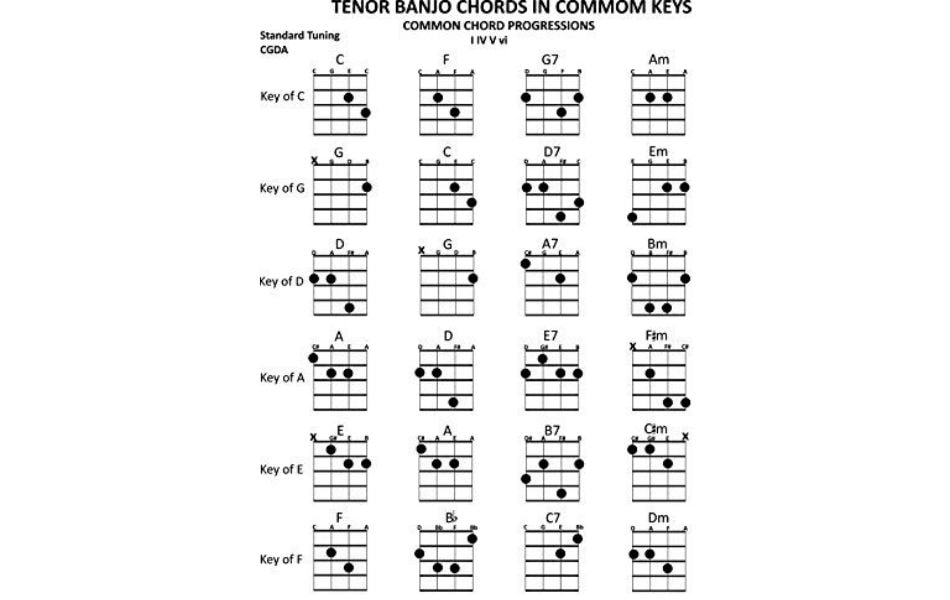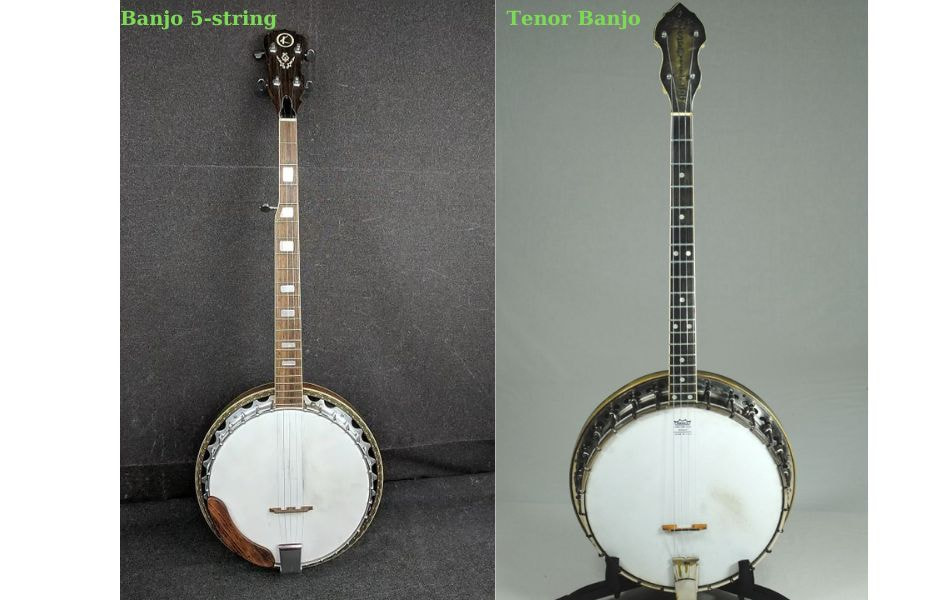In this journey into the world of banjo chords, we’ll explore the fundamental principles of playing 4-string banjo chords. Whether you’re a beginner stepping into the realm of this iconic instrument or a seasoned player seeking to refine your techniques, this guide will illuminate the paths to forming and transitioning between chords with clarity and precision.
Contents
Basic chord theory of 4-string banjo chords
Chords are groups of notes played together to create a harmonious sound. In 4-string banjo chords. they are formed by pressing down the strings at specific frets to produce different pitches. Understanding chord theory helps you construct and play chords confidently.
Types of Chords:
Major Chords: These chords have a bright and stable sound. They’re typically labeled with the chord letter, such as G, C, D, etc.
Minor Chords: These chords sound somewhat darker than major chords. They are often notated with a lowercase ‘m’, such as Em, Am.
Dominant 7th Chords: These chords have a slightly tense, bluesy quality. They are labeled with the chord letter followed by ‘7’, like G7, C7.

Common 4-String Banjo Chords
Major chords (G, C, D, A)
On a 4-string banjo, major chords are formed by pressing down on the strings at specific frets to produce harmonious combinations of notes. These chords are essential for playing melodies, and accompaniments, and creating a vibrant musical palette.
A major chord consists of three notes – the root, the major third, and the perfect fifth. The root note is the primary note of the chord, defining its tonal center. The major third is the note that’s four half-steps (or two whole steps) above the root, while the perfect fifth is seven half-steps (or three and a half whole steps) above the root.
To play a major chord on a 4-string banjo, follow these steps:
- Identify the root note of the chord you want to play.
- Place your fingers on the corresponding strings and frets to create the major third and perfect fifth notes. The specific finger placement will depend on the chord shape and tuning.
Common Major Chords
C Major: Press your index finger on the second string at the first fret.
D Major:
- Place your thumb on the first string at the first fret.
- Place your index finger on the second string at the second fret.
E Major:
- Place your thumb on the first string at the second fret.
- Place your index finger on the second string at the second fret.
F Major: Place your index finger on the second string at the first fret.
G Major:
- Press your thumb on the second string at the first fret.
- Press your index finger on the fourth string at the second fret.
A Major: Press your middle finger on the third string at the first fret.
B Major:
- Press your thumb on the third string at the second fret.
- Press your index finger on the fourth string at the second fret.
Minor chords (Em, Am)
Minor chords provide a mellow and somewhat melancholic quality to your music. On a 4-string banjo chords, minor chords are formed by adjusting specific notes within a major chord. Just like major chords, minor chords are integral to creating a variety of musical textures and emotions on the banjo.
A minor chord consists of three notes – the root, the minor third, and the perfect fifth. The root note defines the chord’s foundation, while the minor third is the note that’s three half-steps (or one and a half whole steps) above the root. The perfect fifth is seven half-steps (or three and a half whole steps) above the root.
Here are two common minor chords on a 4-string banjo chords:
E Minor (Em): Place your index finger on the second string at the first fret.
A Minor (Am): Place your middle finger on the third string at the second fret.
Dominant 7th chords (G7, C7, D7, A7)
A dominant 7th chord consists of four notes – the root, the major third, the perfect fifth, and the minor seventh. The root and fifth are the same as in major chords, while the major third is the note that’s four half-steps (or two whole steps) above the root. The minor seventh is ten half-steps (or five whole steps) above the root.
Here are some common dominant 7th 4-string banjo chords:
G7:
- Place your thumb on the second string at the first fret.
- Place your index finger on the fourth string at the second fret.
C7:
- Place your index finger on the second string at the first fret.
- Place your middle finger on the fourth string at the second fret.
D7:
- Place your thumb on the first string at the first fret.
- Place your index finger on the third string at the second fret.
- Place your middle finger on the second string at the second fret.
A7:
- Place your middle finger on the third string at the second fret.
- Place your ring finger on the first string at the second fret.
- Place your index finger on the second string at the first fret.
Contrast 4-string banjo chords and 5-string banjo chords
The 4-string banjo has four strings, typically tuned to G, D, B, and D. Whereas, the 5-string banjo has an extra fifth string, usually tuned to G, D, G, B, and D. This fifth string, often called the “drone string,” adds unique tonal qualities and opens up more playing possibilities.

Due to the fewer number of strings, the banjo chords 4-string variations might be more limited. The types of chords you can play depend on the tuning and the availability of notes. With an additional string, the 5-string banjo can offer more chord variations and complex fingerings. It allows for richer voicings and unique chord shapes.
In the harmonious world of the banjo, every chord is a note in the symphony of your journey. The strings you pluck, the frets you press, and the melodies you conjure all unite to create a song uniquely yours. With the mastery of 4-string banjo chords, you’ve unlocked a realm of possibilities – a canvas where emotions, stories, and experiences intertwine.
